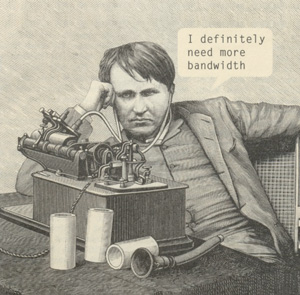You’e had your faithful T1 line service for years, maybe even decades. You love the reliability, solid bandwidth, low latency and the fact that prices have even declined from contract to contract. The one limitation that’s becoming a real bottleneck is the bandwidth. While 1.5 Mbps was plenty a decade ago, it’s not keeping up anymore. Is there any way to keep the performance of T1 but goose up the speed? Most definitely!
 What Makes a Good T1 line Replacement
What Makes a Good T1 line ReplacementWhen you first took out your T1 contract, you chose this technology for good reasons. DSL was popular for business at the time, but notoriously unreliable. T1 had the advantage of being a service that was developed by the telephone companies for the telephone companies. That meant it was professional grade from the beginning and not a “consumer” service being offered for business as a cheap option.
T1’s fixed 1.5 Mbps bandwidth was dictated by the need to multiplex or combine 24 individual analog phone lines into a single digital equivalent that maintained all the voice quality, including minimal latency. T1 also had to run on existing twisted pair telco lines no matter how far they stretched. That’s why T1 is available far out into rural areas beyond the reach of other options.
T1 is still used to provide multiple phone lines for key telephone and PBX systems. It has been expanded to support packet-based digital networks including point to point dedicated lines and dedicated Internet access. Many T1 lines come with a Service Level Agreement (SLA) that provides a guarantee of availability and performance from the service provider.
Bonded T1
One way to increase the bandwidth of T1 lines is to simply add more of them. Most companies want that bandwidth combined, which is easily done by carriers using a process called bonding. All of the T1s you want bonded must be from the same provider. Two T1 lines gives you 3 Mbps, 4 lines give 6 Mbps and so on. You can go up to 10 or 12 bonded T1 lines, but the cost gets prohibitive unless this is your only option.
Ethernet over Copper
Ethernet over Copper uses the same twisted pair infrastructure as T1, but a newer modulation technology. You lose the unlimited distance advantage but gain much higher bandwidths, generally up to 10 or 20 Mbps, at more reasonable prices. If you are located in a populated area, EoC can give you the service you want at a fraction of the cost of bonded T1 lines.
DS3 Bandwidth
DS3 is part of the T-Carrier specification that also defines T1. DS3 offers 45 Mbps, enough for many businesses. Low latency, dedicated lines and reliable service are similar to T1 lines. The only wrinkle is that the higher bandwidth of DS3 isn’t supported over twisted pair copper. Instead, DS3 rides a fiber optic backbone to the curb and then a pair of small diameter coaxial copper lines to your router DS3 interface card.
Fiber Optic Service
Fiber service used to be well beyond the financial reach of most companies even if it was available… and it often wasn’t. That’s all changed. SONET technology, which transports DS3 and the higher bandwidth services like OC3, OC 12, and OC48, has become more available and less expensive. Ethernet over Fiber is the newer technology and it is much less expensive for the same high quality service. Many, many companies order 10 Mbps Ethernet over Fiber service and then easily upgrade to 50 or 100 Mbps as they need it. Bandwidths are readily available to 1 Gbps and even 10 Gbps in many areas.
What about Cable, Satellite, Wireless, Etc?
These less expensive services are shared, not dedicated bandwidth. That’s a major reason they are less expensive. Most are asymmetrical, meaning that upload speed is only a fraction of download speed. Satellite has tremendous latency effects and both satellite and wireless tend to have data caps. That said, a lot of businesses are saving a lot of money each month, especially if they combine a couple of low cost broadband services in a SD-WAN or Software Defined Wide Area Network. It all depends on how demanding your applications are and whether you prefer to avoid the Internet to connect locations. Get some expert advice and then pick the best bandwidth option appropriate for your business needs.

